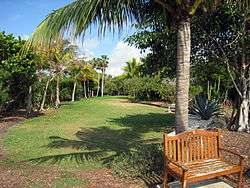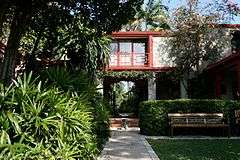The Kampong
| The Kampong | |
|---|---|
 | |
| Type | Private |
| Location |
4013 Douglas Road, Coconut Grove, Miami, Florida, United States |
| Area | 11 acres (45,000 m2) |
| Created | 1984 |
| Operated by | National Tropical Botanical Garden |
| Website | The Kampong |
|
The Kampong | |
|
Original Fairchild home with Sweeney addition from courtyard | |
   | |
| Coordinates | 25°42′53″N 80°14′59″W / 25.71472°N 80.24972°WCoordinates: 25°42′53″N 80°14′59″W / 25.71472°N 80.24972°W |
| Architect | Edward Clarence Dean and Max Strang |
| Architectural style | Mission/Spanish Revival |
| NRHP Reference # | 84000837[1] |
| Added to NRHP | March 1, 1984 |
The Kampong is a 9-acre botanical garden in the Coconut Grove neighborhood of Miami, Florida, United States. It is one of the five gardens of the non-profit National Tropical Botanical Garden (NTBG), and is open to visitors Monday through Saturday by advance reservation. An admission fee is charged.
History
The Kampong was bought as a winter home by the famed horticulturalist Dr. David Fairchild and his wife Marian in 1916.[2] For many years he managed the Department of Plant Introduction program of the U.S. Department of Agriculture in Washington, D.C., searching the world for plants that could be useful and successfully introduced into the United States. Fairchild introduced around 30,000 plant species and varietals into the U.S.
At his home in Florida, Fairchild created a garden that contained many of the plants that he obtained throughout his trips. In 1931 Marian's sister Elsie and her husband, Gilbert Hovey Grosvenor, acquired the adjoining property on the north to use as their winter home.[3] Fairchild and his wife made the Kampong their permanent home from 1928 until their deaths in 1954 and 1962 respectively.
A year after David Fairchild's wife's death, the land was purchased by Catherine Hauberg Sweeney, a botanist and preservationist.[4] Sweeney maintained Fairchild’s garden and was vital in its preservation for future use and study, securing its listing on the National Register of Historic Places. In 1984 Sweeney donated the property to the then Pacific Tropical Botanical Garden (now National Tropical Botanical Garden), and remained its principal sponsor until her death in 1995.
Leadership
The Kampong's first Director from July 1996 to February 1998, Dr. Thomas Lodge, oversaw completion of The Fairchild-Sweeney House renovations. He also was key in researching David Fairchild's role in the establishment of Everglades National Park. Larry Schokman served as Mrs. Sweeney's superintendent for 11 years, until 1984 when The Kampong became part of the National Tropical Botanical Garden (NTBG), and Schokman became an NTBG employee. As Director of Horticulture and then Assistant Director under Dr. Lodge, Schokman maintained a close working and personal relationship with Sweeney until her death in 1995. He became Director of The Kampong in 1998 and retired in August 2007.
Following Schokman, Dr. David Lee was Director of The Kampong from 2007 to 2009. Dr. Lee was formerly the Chair of Biological Sciences at Florida International University, where he worked for 26 years. Dr. Lee helped to safeguard The Kampong's southern boundary from development encroachment, and provided guidance for The Kampong's Board of Governors.
In 2009, Ann Parsons took on the role of Director of The Kampong. Formerly the Director of Education at Norfolk Botanical Garden, Parsons, along with Curator of Living Collections David T. Jones, are tasked with preserving the rich legacy of The Kampong while planning for the future. They are doing just that—in 2011, more than 5,000 guests visited the historic estate and garden through tours, educational programs and special events. These visitors are key in helping spread The Kampong's message about the importance of protecting, preserving, and studying tropical plants.
Facilities
Today the Kampong's living collections include tropical fruits including pomelo, 23 cultivars of avocado, and 65 varieties of mango, palms, flowering trees, ficus, aroids, and bamboo.[5] This garden serves as the mainland campus for the NTBG. Major aspects of the Kampong include:
- The Fairchild-Sweeney House – designed by architect Edward Clarence Dean, constructed in 1928,[6] as a combination of Spanish and Southeast Asian influences. A later renovation to the home incorporated more modern features and added a second floor over a portion of the home, resulting in an unusual blend of styles. Visitors included Thomas Edison and Henry Ford.
- Schokman Education Center – designed by architect Max Strang, completed in 2007, as an outdoor pavilion incorporating oolitic limestone and exposed concrete.[7]
- Mangrove preserve – one of the largest areas of salt-water mangrove forest in the area, containing all four mangroves native to the area, as well as Bruguiera gymnorrhiza from the Philippines.
See also
- Fairchild Tropical Botanic Garden
- National Tropical Botanical Garden
- McBryde Garden
- Allerton Garden
- Limahuli Garden and Preserve
- Kahanu Garden
- List of botanical gardens in the United States
References
- ↑ National Park Service (2010-07-09). "National Register Information System". National Register of Historic Places. National Park Service.
- ↑ Zuckerman, Bertram. The Kampong. (Coral Gables, FL): National Tropical Botanical Garden, 1993. p.11.
- ↑ Zuckerman. p. 88.
- ↑ Zuckerman. p. 139.
- ↑ The Kampong of the National Tropical Botanical Garden (booklet), 2008,
- ↑ Zuckerman. p. 85.
- ↑ Shulman A, Miami Architecture, University Press of Florida, 2010, p. 141.
External links
| Wikimedia Commons has media related to The Kampong. |
